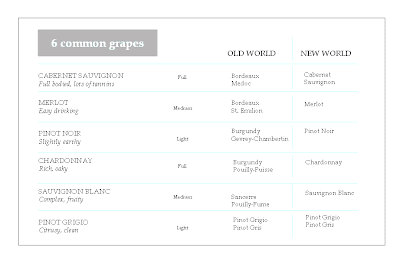OK. There are people who really seem to know their wines. They easily throw around words like "acidity", "tannins" and, my favorite, "terroir"! (Oooo. Scary!) It almost feels like they're using another language. Who are these people? Where did they learn all this stuff? And how did they learn all this stuff? I usually feel so inadequate around them. It's like an exclusive club where my nose is pressed to the glass looking in.
But there is a little known secret. In reality, these folks know only a small fraction of wine information available. Even the course instructors, wine writers and sommeliers admit it's tough for them to keep it all straight - after years in the business!? The industry is totally disjointed. Labeling, terminology and flavor profiles not only change by country, but also the geographic region within the country. Huh? Forget that. How do I, the lowly one, sort through it then? Choose the one with the best designed label? Not to worry. Help is on the way.
Over the years, I collected some pieces of information that help make selecting wines for food a little more "user friendly." I call them the Simple Seven. They don't (and can't) simplify everything. Be mindful they contain some broad generalizations so there will be exceptions, e.g. don't try to go toe to toe with the Wine Steward, please. For me, these little rules help pare down the vast universe of options, making the final analysis/ decision a little less daunting and a little more enjoyable.
One last note, what's emphasized over and over, is that the main decision criteria is YOU. Your taste. Your preference. Always, always, go with what you like. Similar to the clothes you wear, wine selection is very personal. So if you drink and enjoy what you love, you'll always have the right bottle.
Wine Pairing: SIMPLE SEVEN
1. Narrow the wine universe Part 1: break it into two categories - Old World vs New World
This is a great macro level starting point. Consider the Old World as those wines coming from France , Italy , Germany and Spain Bordeaux , Burgundy
New World wines are more of the late-comers to the market like USA , Australia , South Africa and Chile
Start to see which one of these categories you tend to prefer then center your focus (in the wine store, on the wine list) in that area.
2. Look for wines with a higher acidity
These wines generally pair better with food. Think about it. What better way to balance some of the rich foods we tend to eat. Cream sauces, fried foods, cheeses all need a wine that can hold up and not get lost. Whites are more acidic than reds. Wines from colder climates also tend to be more acidic than from warmer ones.
3. Avoid wines with higher amounts of alcohol
High alcohol content has the tendency to dry out the mouth and taste buds, decreasing our ability to experience food flavors. These wines are to be enjoyed more on their own. (See also #4 Spicy foods.)
4. Spicy foods pair better with lighter, higher acidic whites (not high alcohol)
This is especially true for Asian and Indian cuisine. The bitterness found in tannins (from grape skins) in reds can clash with some of the flavors. Some lighter reds, however, can work well, like a Zinfandel or Pinot Noir. Also be wary of high alcohol content with spicy foods. It can increase the heat sensation in the mouth.
5. Narrow the wine universe Part 2: focus on the 6 most common grapes
Another easy way to narrow the myriad of options is to focus on the 6 most common grapes. They represent the majority of the wines you'll most likely encounter. They also provide a delicious range of flavors from the most robust to the most delicate. There's something for everyone. See chart below.
6. Let the dominant flavors of the food drive the wine pair, NOT the protein
How often we have heard "red wine for red meat and white wine for white meat." While I am always a fan of generalizations to help ease the decision process, this, however, is NOT one of them. The more important factors are: 1.) the dominant flavors of the dish being served and whether they are a complement/conflict with the wine and 2.) the richness of the dish and the corresponding weight of the wine. Pairing a big, powerful, high-tannin wine with a delicate dish (or vice versa) is rarely a good idea.
7. Don't upstage the star
If you have an amazing bottle of wine, don't upstage it with a wildly complex dish. Usually a great bottle of wine is great because of its subtleties. Consider a more simple dish to give the wine "more of the center stage."
Of course, the deeper you go, the more stuff can be added. I purposefully kept it short so that it remains an everyday "go-to" resource, vs another dusty old thing that sits on the shelf. And be honest with yourself, if this still feels like too much, there are still a bunch more resources* at your disposal.
*Some hints for you:
- a credible salesperson at a wine specialty store
- a good sommelier at a restaurant
- www.foodandwinepairing.org
- www.foodandwine.com
- see User-Friendly list at right

